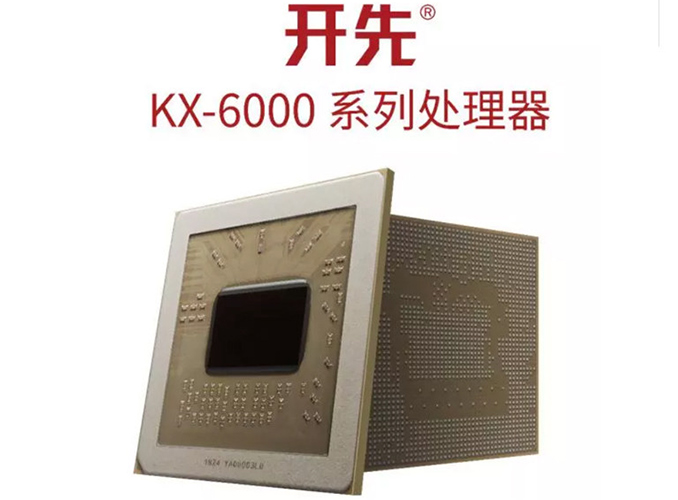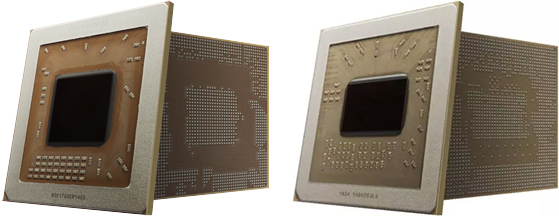Zhaoxin Displays x86-Compatible KaiXian KX-6000: 8 Cores, 3 GHz, 16 nm FinFET
by Anton Shilov on September 24, 2018 12:00 PM EST
Zhaoxin, a joint venture between Via Technologies and the Chinese government, this week for the first time displayed its upcoming x86-compatible CPU, the KaiXian KX-6000. The SoC features eight cores running at 3 GHz and increases performance over its predecessor by at least 50%.
The KaiXian KX-6000 is a successor to the KX-5000 CPU launched earlier this year. Both chips integrate eight-core x86-64 cores with 8 MB of L2 cache, a DirectX 11.1-capable iGPU with an up-to-date display controller, a dual-channel DDR4-3200 memory controller, contemporary I/O interfaces (PCIe, SATA, USB, etc), and so on. The key differences between the KaiXian KX-5000 and the KaiXian KX-6000 are frequencies and manufacturing technology: the former is produced using TSMC’s 28 nm fabrication process and runs at up to 2 GHz, whereas the latter is made using TSMC’s 16 nm technology and operates at up to 3 GHz. Zhaoxin claims that the Kaixian KX-6000 offers compute performance comparable to that of Intel’s 7th Generation Core i5 processor, which is a quad-core non-Hyper-Threaded CPU. Obviously, performance claims like that have to be verified, yet a 50% performance bump over the direct predecessor already seems beefy enough.
As the picture below shows, the thinner manufacturing process enabled Zhaoxin to make the KaiXian KX-6000 die smaller when compared to the predecessor, which will eventually shrink its manufacturing cost. Meanwhile, the two processors use different HFCBGA packaging and therefore cannot use the same motherboards. Meanwhile it is unknown whether the new KaiXian KX-6000 is compatible with Zhaoxin’s USB 3.1 Gen 2-capable ZX-200 chipset.
The Zhaoxin KaiXian KX-6000 relies on the LuJiaZui microarchitecture, which is an evolution of the WuDaoKou microarchitecture that powers the KX-5000 processor introduced in early 2018. Based on what we know today, the LuJiaZui is an x86-64-compatible superscalar, multi-issue, out-of-order microarchitecture that supports contemporary instruction sets extensions like SSE 4.2 and AVX along with virtualization and encryption technologies. Zhaoxin has yet to disclose differences between its LuJiaZui and WuDaoKou designs. Therefore, all we can do is speculate that since the microarchitectures are launched within one year from each other they are very similar, but the newer one has minor optimizations that, perhaps, enable higher clocks, improved caching, better memory support, etc.
Zhaoxin has not announced when it plans to start commercial shipments of its KaiXian KX-6000 processors, as right now it only displays its picture (which proves that it exists). Based on the previously published roadmap, we'd expect the CPU to hit the market in 2019, though when exactly is anyone's guess.
| Zhaoxin's Kaixian KX-5000 and KX-6000 CPUs | |||
| Kaixian KX-5000 WuDaoKou |
Kaixian KX-6000 LuJiaZui |
||
| Core Count | 4 - 8 | Up to 8 | |
| L2 Cache | 8 MB | 8 MB | |
| Frequency | Up to 2 GHz | Up to 3 GHz | |
| ISA | x86-64 | ||
| ISA Extensions | SSE 4.2, AVX | ? | |
| APIC | Yes | ||
| Virtualization | VMX technology, compatible with Intel's VT-X | ||
| Temperature monitoring, overheat protection | Yes | ||
| Power States | C1, C2, C3, C4, P-State | ? | |
| Hardware Encryption Engines | Advanced encryption engine (ACE), SHA-1, SHA-256, SM3/SM4, Randomizer | ? | |
| Security | TXT, EDB | ? | |
| iGPU | DirectX 11.1 feature set. Hardware-accelerated video encoding/decoding. Outputs: DP, eDP, HDMI, D-Sub Max Resolution: 4K Number of Displays: 3 |
? | |
| Packaging | x-ball HFCBGA 37.5 x 37.5 mm |
y-ball HFCBGA 37.5 x 37.5 mm |
|
| Process Technology | TSMC 28 nm | TSMC 16 nm FinFET | |
Related Reading:
- Cypress and Zhaoxin Have USB 3.1 Gen 2 USB Controllers
- China Calling: AMD Forms Joint Venture for x86 Server SoCs in China
- AMD Creates Quad Core Zen SoC with 24 Vega CUs for Chinese Consoles
Source: PC Watch











77 Comments
View All Comments
wurryno - Monday, September 24, 2018 - link
China has been seeking their own x86-64 CPU's when Obama restricted sales of high-end CPU's to China in 2015. It takes time to develop CPU's and time to plan. It isn't about Trump.yannigr2 - Monday, September 24, 2018 - link
Wow, so many Americans in here posting again and again that China stole the technology. Thank God the Americans don't bomb other countries to stole their resources.Speedfriend - Monday, September 24, 2018 - link
Maybe they should ask Imagination Technology how they feel about Americans stealing intellectual property!bji - Monday, September 24, 2018 - link
How do you know they are Americans posting? Oh that's right you don't. Now whose prejudices are showing?CrispySilicon - Monday, September 24, 2018 - link
https://www.tomshardware.com/news/x86-hidden-god-m...I'm guessing that IP is going kept current..... (hint hint, nudge nudge, wink wink)
RaduR - Monday, September 24, 2018 - link
Used to love Cyrix (they somehow invented cache in 386DX era) . They were a small company that gave Intel & AMD a run for their money . They were kind of AMD of today (size wise compared to INTEL and AMD) . These guys were good.VIA has nothing to do with that great company , they just bought them.
Also that Nemiah Core with god mode is not developed by them , but bought from Centaur .
So VIA never made any CPU by themselves , just great South&Nortbridge at the time.
Now since they are chinese ( Taiwan whatever) they are playing the right cards.
VIA has great patents in their portfolio ( Cyrix, Centaur, S3) they should capitalize on that , they should have done it long ago. Having TSMC in the same country its amazing they waited so long.
wumpus - Thursday, September 27, 2018 - link
Cache was an old trick by then (the 68k had something like 512B of cache. Don't laugh, that's only half of what the 486DLC had...) and I'm pretty sure invented when computers were still using magnetic core memory (I'm sure I read about them EE textbooks written before the 80386 was announced).But yes, Cyrix was an impressive company. The biggest irony is that they got started by making a faster floating point processor than the 80287 (possibly the 80387, but I think they made both) but were really slagged on just how bad their Quake performance was.
And as far as I know, VIA shut Cyrix down right after they bought it. All they kept was the name and the patent porfolio.
RaduR - Tuesday, October 2, 2018 - link
Yes you are correct , this is the irony . The CPU was pretty good at the time (I had one , huge heatsink , FSB 75Mhz a lot of overclocking ) but the FPU was not that good. Actually Quake destroyed this company without knowing it.Old stories like 3DFx Vodoo & co :-) very funny that this still lives today in China.
I'm still surprised that chinese goverment is not buying ARM licence and produce whatever they want even big cores that run Linux without any problem. Why stick with x86 ?
oRAirwolf - Monday, September 24, 2018 - link
I am honestly kind of surprised that the Chinese government was willing to work with a Taiwanese company.serendip - Monday, September 24, 2018 - link
Foxconn has a massive presence in China and it's a Taiwanese company. You can't get to that size without having government support.